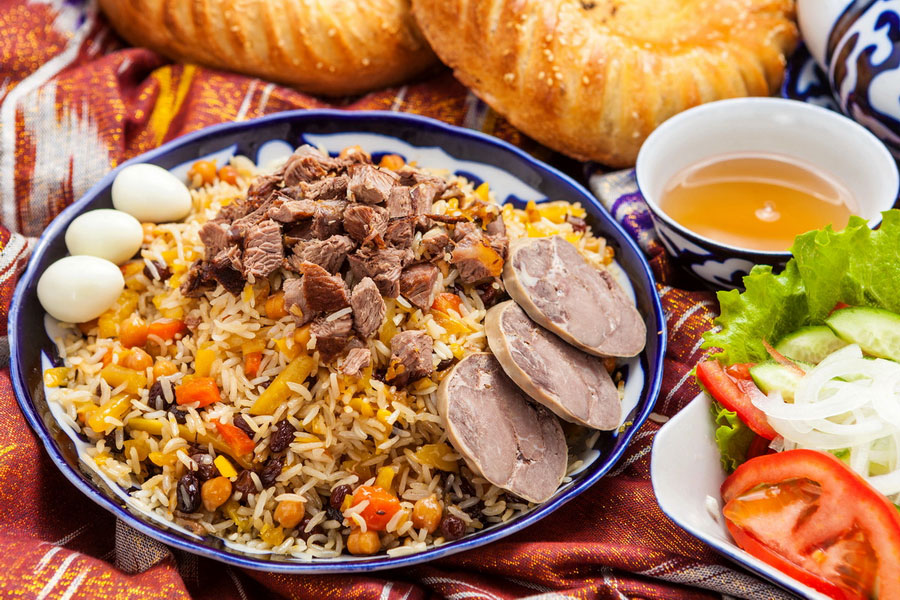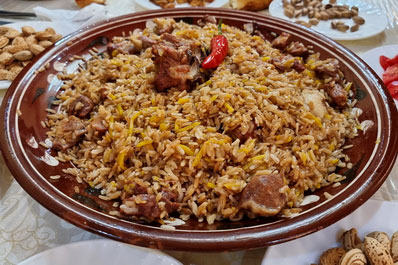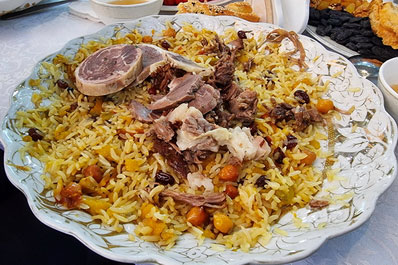Uzbek Pilaf

Plov (pilaf, palov) reigns supreme in Uzbek cuisine, cherished by all in Uzbekistan regardless of age, nationality, or social status. Esteemed as the ultimate emblem of Uzbek hospitality, plov has even earned a spot on UNESCO's list of intangible cultural heritage.
Uzbeks prepare plov for virtually any occasion: grand festivals, intimate family dinners, and even memorial services are incomplete without it. The tradition of "morning plov" is particularly noteworthy. For celebrations like weddings or circumcisions, a colossal cauldron of plov is prepared, welcoming hundreds of guests. It's customary to recite prayers before indulging in this morning feast.
Plov's centuries-long history not only marks it as a cornerstone of Central Asian culinary art but has also garnered international acclaim for its rich flavors, aromatic presence, and the traditions enveloped in its preparation.
The origin story of plov intertwines with the legend of the scholar and physician Abu Ali Ibn Sino (Avicenna). Approached by the ruler of Bukhara for his ailing son who had lost his appetite, Ibn Sino diagnosed love at the heart of the boy's condition who was in love with the craftsman's daughter. Avicenna's prescription was unique: a steady diet of plov (palov osh) until the prince regained his strength, culminating in a wedding between the young lovers.
Another tale credits Alexander the Great's cooks with inventing plov. Known for his preference for spicy food, Alexander found a rice, carrot, and red pepper dish too fiery. The addition of apricots, grapes, and barberries softened the dish's heat, winning Alexander's approval.
"Plov" or "palov osh" cleverly derives its name from the initial letters of its primary ingredients: Onion (piyoz), Carrot (ayoz), Meat (lahm), Fat (olio), Salt (vet), Water (ob), and Rice (shaly).
Traditionally, plov is prepared in massive cauldrons (called kozon), cooked over an open flame under the sky, with ingredients measured by the kilogram. Only the finest ingredients make the cut for plov, including a special long-grain rice that perfectly balances tenderness and bite.
Plov's diversity is vast, with dozens of variations across Uzbekistan, each region adding its unique twist. This dish isn't just about sustenance; it's a celebration of centuries-old traditions and recipes passed down through generations. A trip to Uzbekistan wouldn't be complete without sampling the myriad versions of plov across its cities.
In Tashkent, the festive or wedding plov (tuy oshi) holds a special place in people's hearts, featuring long-grain laser rice, dried fruits, large peas, boiled horse meat pieces, and quail eggs among its ingredients. The chaihan plov, distinguished by its method of preparation and the use of devzira rice, is also a local favorite.
The Fergana Valley, known for its devzira rice, presents a beloved version of chaihan plov, rich in oil and occasionally spiked with hot chili pepper.
Samarkand's plov stands out for its use of long rice and yellow carrots, flavored with a dark oil made from flax seeds, making it a healthier option.
Bukhara prefers a sweeter plov, enriched with dried fruits and prepared by boiling ingredients separately before layering them in the cauldron for a final stewing. Meanwhile, Khiva and the Khorezm region favor a lighter plov with minimal spices and oil, showcasing the versatility and regional diversity of this beloved dish.



